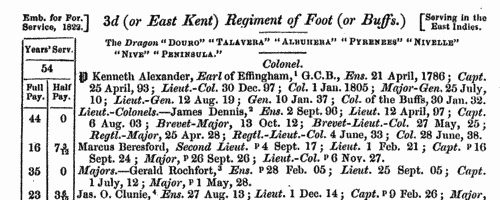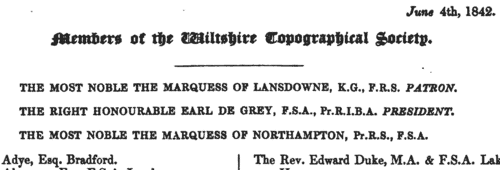Add this eBook to your basket to receive access to all 155 records. Our indexes include entries for the spelling gibbes. In the period you have requested, we have the following 155 records (displaying 101 to 110): These sample scans are from the original record. You will get scans of the full pages or articles where the surname you searched for has been found. Your web browser may prevent the sample windows from opening; in this case please change your browser settings to allow pop-up windows from this site. Dissolutions of Partnerships
(1840)
Trade partnerships dissolved, or the removal of one partner from a partnership of several traders, in England and Wales
| Sample scan, click to enlarge

| Officers of the British Army
(1840)
The New Annual Army List, corrected to 7 February 1840, was published in London by Lieut. H. G. Hart. It lists all serving officers, first of all a list of General and Field Officers by rank from field marshal down to major; and then by regiment, including all ranks down to ensign, with paymasters, adjutants, quarter-masters, surgeons and assistant-surgeons. These lists are all annotated with dates of rank in the army and regiment, and with symbols indicating the officers present at Trafalgar (T), in the Peninsula or the South of France (P), and Waterloo (W). A superscript p indicates that the commission was purchased; an asterisk that it was temporary. The regiments and units are listed in order of precedence: Head Quarters staff; Life Guards; Horse Guards; 7 regiments of Dragoon Guards; 17 regiments of Dragoons; 98 regiments of Foot; the Rifle Brigade; two West India regiments of Foot; Ceylon Rifles; Royal African Colonial Corps; Cape Mounted Rifles; Royal Newfoundland Veterans; Royal Malta Fencibles; Recruiting Staff; Royal Artillery; Royal Engineers; Royal Marines; Commissariat; and the Medical Department. | Sample scan, click to enlarge

| British Army administration
(1841)
The British Army of queen Victoria's time had a very extensive system of administration. The Royal Kalendar lists officials, both uniformed and civilian, from the Commander-in-Chief's Office at Horse Guards, the Adjutant-General's Office, the Recruiting Department, the Quarter Master-General's Office, the Judge Advocate-General's Office, the Consolidated Board of General Officers, the Cinque Ports, the War Office, the Office of her Majesty's Paymaster-General, the Ordnance Department (including the out-ports and stations at Woolwich, Chatham, Dover, Portsmouth, Devonport, Guernsey, Jersey, Chester and Liverpool, Carlisle, Hull, Landguard Fort and Harwich, Alderne, the gunpowder manufactory at Waltham Abbey, the gunpowder magazines at Hyde Park, Purfleet, Gravesend and Tilbury, Upnor Castle, Priddy's Hard, Tipner Point, Keyham Point, Marchwood and Tynemouth; at Edinburgh, Stirling Castle and Fort George in Scotland; in Antigua, Australia, the Bahamas, Barbadoes, Berbice, Bermuda, Cape of Good Hope, Colombo, Corfu, Demerara, Dominica, Gibraltar, Grenada, Halifax (Nova Scotia), Jamaica, Isle aux Nois, Kingston (Upper Canada), Malta, Mauritius, Montreal, New Brunswick, Prince Edward's Island, Quebec, Rideau Canal, Ottawa Canals, St Christopher, St Helena, St Lucia, St Vincent's, Santa Maura, Sierra Leone, Toronto, Tobago, Trincomalee, Trinidad and Zante), the Royal Military College at Sandhurst, the Royal Hospital at Chelsea, the Royal Military Asylum at Chelsea and Southampton, Army Agents, General Agents for the Recruiting Service, and Army general staff and governors of forts and garrisons in Ireland. | Sample scan, click to enlarge

| British Army officers
(1841)
The Royal Kalendar lists general and field officers of the British Army - five Field Marshals, 95 generals, 138 major-generals, 310 colonels, 637 lieutenant-colonels, 697 majors, in order of precedence according to year of precedence, and with the regiment indicated for each; then there are aides-de-camp to her Majesty queen Victoria; retired officers specially allowed to retain their ranks; and then the queen's land forces, set out regiment by regiment and battalion by battalion, naming the colonel, lieutenant-colonel and major for each, officers of the British garrisons, and of the Tower of London; and the officers of the Royal Regiment of Artillery (including the Field Train) and the Corps of Royal Engineers, by rank. | Sample scan, click to enlarge

| London trading companies
(1841)
The Royal Kalendar lists governors, directors, officials and assistants of the main commercial and trading establishments incorporated in London: the South Sea Company, the Russia Company, the Eastland Company, the Hudson's Bay Company, the Canada Company, Van Diemen's Land Company, Corporation for Smelting Down Lead with Pit and Sea Coal, Corporation for Working of Mines, Minerals and Metals in Scotland, English Copper Company, North American Colonial Association, British American Land Company, Committee for Managing the Affairs of Lloyd's Register of British and Foreign Shipping, Society of Guardians for the Protection of Trade, Standing Committee of West India Planters and Merchants, African Committee for the Forts on the Gold Coast, East and West India Dock Company, London Dock Company, Commercial Dock Company, Grand Surrey Canal Dock Company, St Katharine Dock Company, Regent's Canal Company, New River Company, East London Water Works, Vauxhall Water Works, West Middlesex Water Works, Grand Junction Water Works, Lambeth Water Works, Gas Light and Coke Company, Phoenix Gas Light and Coke Company, Imperial Gas Light and Coke Company, General Shipowners Society, and a large number of insurance societies. | Sample scan, click to enlarge

| Medical men
(1841)
The Royal Kalendar lists fellows, candidates, inceptor candidates, licentiates and extra-licentiates of the Royal College of Physicians (giving a general address for those outside London, a street address for those living in London); the council of the Royal College of Surgeons in London; and officials of the Society of Apothecaries of London. | Sample scan, click to enlarge

| Officials in the British colonies
(1841)
The Royal Kalendar lists officials in the British colonies, arranged by continent: in Gibraltar, Malta, the United States of the Ionian Islands (Corfu, Cephalonia, Zante, St Maura, Ithaca, Cerigo and Paxo), and Heligoland in Europe; in Lower Canada, Upper Canada, Nova Scotia, New Brunwick, the Island of Prince Edward, Newfoundland, Jamaica, the Bahamas, Honduras, Barbadoes, St Vincent, Grenada, Tobago, Trinidad, St Lucia, Antigua, Montserrat, St Christopher's, Nevis, the Virgin Islands, Dominica, British Guiana, Berbice and Bermuda in the Americas; Ceylon, New South Wales, Van Diemen's Land, Western Australia and South Australia in Asia (and Australasia); Cape of Good Hope, St Helena, Mauritius, Sierra Leone and Gambia in Africa.
| Sample scan, click to enlarge

| The household of Queen Victoria
(1841)
The Royal Kalendar lists the staff of the royal household: the Lord Chamberlain's Department (including the Keeper of her Majesty's Privy Purse, the Master of the Ceremonies, the Mistress of the Robes, the Ladies of the Bedchamber, Maids of Honour, Bedchamber Women, Lords in Waiting, Grooms in Waiting, Gentlemen Ushers, Quarterly Waiters in Ordinary and Grooms); the Office of the Robes (including Pages, Gentlemen of the Privy Chamber and Sergeants at Arms); the Band of Music; Medical Department; Chapel Royal; Lord Steward's Department (including the Board of Green Cloth, Ewry, Wine and Beer Cellars, Kitchen, Confectionery, Silver Pantry, Coal Yard, Servants Hall, State Porters, Court of Marshalsea, Marshalsea Prison, Almonry, and Gardners; Gentlemen-at-Arms; the Queen's Stables, the Master of the Horse's Department, and the Royal Hunt. | Sample scan, click to enlarge

| Deaths, Marriages, News and Promotions
(1842)
Death notices and obituaries, marriage and birth notices, civil and military promotions, clerical preferments and domestic occurrences, as reported in the Gentleman's Magazine. Mostly from England and Wales, but items from Ireland, Scotland and abroad.
| Sample scan, click to enlarge

| Members of the Wiltshire Topographical Society
(1842)
This list of the names and addresses of the Wiltshire Topographical Society is correct as of 4 June 1842. | Sample scan, click to enlarge

|
Research your ancestry, family history, genealogy and one-name study by direct access to original records and archives indexed by surname.
|











